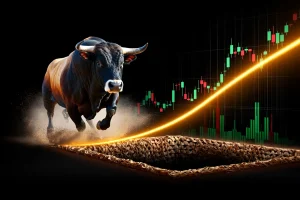
Why Do Investors Panic-Sell During Market Downturns?
Jun 16, 2025
March 2020: The S&P 500 plummets 34% in five weeks. Millions of investors frantically hit the sell button, liquidating decades of accumulated wealth in pure terror. Retirement accounts evaporate. College funds vanish. The same investors who confidently bought stocks at market peaks now dump them at generational lows, locking in devastating losses just weeks before one of history’s most explosive recoveries begins.
This wasn’t rational portfolio management—it was primal psychological warfare. The same fear response that once saved our ancestors from sabre-toothed tigers now destroys modern investors’ financial futures. Why do investors panic-sell during market downturns? Because market crashes don’t just attack portfolios; they assault the deepest vulnerabilities in human psychology, turning disciplined investors into terrified sellers.
Understanding this phenomenon separates wealth builders from wealth destroyers. In today’s volatile markets, the investors who master their psychological responses don’t just survive downturns—they use them as springboards to extraordinary returns.
The Neurological Basis of Financial Panic
Loss aversion forms the psychological foundation of panic-selling behavior. Neuroscience research reveals that humans feel the pain of financial losses approximately 2.5 times more intensely than the pleasure of equivalent gains. When portfolio values drop, investors’ brains activate the same threat-detection systems that once protected against physical danger.
This creates a neurological short-circuit. The prefrontal cortex—responsible for rational analysis—gets hijacked by the amygdala’s fight-or-flight response. Suddenly, long-term investment strategies get abandoned in favor of immediate threat elimination through selling.
Recency bias amplifies this panic response. During market downturns, investors’ brains overweight recent negative experiences while discounting historical recovery patterns. The 2008 financial crisis, the dot-com crash, or the COVID-19 selloff feel more relevant than the numerous recoveries that followed.
Social proof then transforms individual fear into collective stampede. When investors see others selling, their brains interpret this activity as validation of their own panic. The more people selling, the stronger the psychological signal becomes, creating self-reinforcing cycles that drive prices far below intrinsic values.
The Anatomy of Market Panic
Modern financial markets have evolved into sophisticated panic amplification systems. High-frequency trading algorithms detect selling pressure and accelerate it. Social media platforms spread fear-based narratives at viral speeds. ETFs and mutual funds face redemption pressures that force additional selling regardless of fundamental valuations.
Confirmation bias locks investors into destructive selling patterns. Once they decide markets are dangerous, they actively seek information that validates their fear while ignoring contradictory evidence. Bear markets become echo chambers where pessimistic predictions get amplified and optimistic voices get dismissed as “delusional.”
The COVID-19 crash perfectly illustrates this psychology. In March 2020, investors sold everything—stocks, bonds, gold, even toilet paper companies—despite many businesses having strong balance sheets and adaptable business models. Fear overwhelmed analysis, creating indiscriminate selling that ignored fundamental differences between companies.
Anchoring bias makes recovery seem impossible during panic episodes. Investors mentally anchor to recent portfolio highs, making current losses feel catastrophic and permanent. A 30% decline doesn’t feel like a temporary setback; it feels like a financial apocalypse.
When Fear Creates Generational Opportunities
The most successful investors understand that panic-selling creates the market’s greatest opportunities. Warren Buffett didn’t build his fortune during bull markets—he built it by buying when others were selling in terror. The 2008 crisis wasn’t a wealth destroyer for Buffett; it was a wealth creator.
Contrarian psychology recognizes that extreme fear often signals market bottoms. When taxi drivers are giving stock tips, it’s time to sell. When financial advisors are recommending cash positions and gold, it’s time to buy. Market panics represent the ultimate contrarian opportunity.
The mathematics of panic-selling reveal its destructive nature. Investors who sold during the March 2020 crash missed the subsequent 100%+ recovery. Those who panic-sold during the 2008 crisis missed the 400%+ gains that followed. Selling during downturns doesn’t just lock in losses—it eliminates the possibility of recovery.
Behavioral arbitrage emerges as a systematic approach to profiting from panic. Instead of fighting fear directly, sophisticated investors identify the psychological patterns driving selling pressure and position themselves to benefit from the inevitable reversal.
The Modern Amplification of Market Panic
Technology has turbocharged panic-selling beyond anything historical markets experienced. Social media algorithms promote engaging content, which often means fear-based financial commentary gets the widest distribution. A single bearish tweet can now trigger billions in selling within minutes.
Passive investing has created new mechanisms for panic amplification. When investors redeem ETF shares during market stress, fund managers must sell underlying holdings regardless of valuations. This creates mechanical selling pressure that can persist longer than traditional panic episodes.
The rise of retail trading apps has democratized panic-selling. Platforms designed for frequent trading make it psychologically easier to sell during market stress. The same apps that gamified investing during bull markets now facilitate wealth destruction during bear markets.
Artificial intelligence and algorithmic trading have created new forms of synthetic panic. Machine learning systems trained on historical data can amplify human psychological biases at superhuman speeds. Flash crashes now occur in milliseconds, not hours.
Breaking Free from the Panic Cycle
Escaping panic-selling requires more than intellectual understanding—it demands systematic processes that counteract psychological programming. The most effective approach combines behavioral awareness with disciplined investment frameworks.
Develop predetermined selling criteria that aren’t based on portfolio performance or market sentiment. This means establishing fundamental thresholds—like deteriorating business models or excessive valuations—that trigger sales regardless of whether markets are rising or falling.
Create systematic rebalancing processes that force contrarian behavior. When asset prices fall below predetermined levels, systematic rebalancing requires buying, not selling. This mechanical approach removes emotion from the most critical investment decisions.
Position sizing becomes crucial for panic prevention. Investors who over-leverage or concentrate too heavily in risky assets are more likely to panic-sell during downturns. Proper diversification and conservative position sizing provide the psychological comfort needed to maintain discipline during market stress.
The Anti-Panic Investment Protocol
Stop checking portfolio values obsessively during market downturns. Stop consuming financial media that profits from fear and panic. Stop making investment decisions based on recent market performance.
Instead, start building cash reserves during bull markets to take advantage of panic-selling opportunities. Start developing written investment plans that specify exactly when and why you’ll sell investments. Start viewing market downturns as wealth transfer events from emotional investors to disciplined ones.
Remember this fundamental truth: Panic-selling is a wealth destruction strategy disguised as risk management. The investors who consistently build wealth don’t avoid market downturns—they prepare for them. They understand that panic creates opportunity, not catastrophe.
The next market downturn is inevitable. The question isn’t whether you’ll experience fear—it’s whether you’ll let that fear control your investment decisions. Choose wisely, because the difference between panic-selling and disciplined buying often determines decades of financial outcomes.












